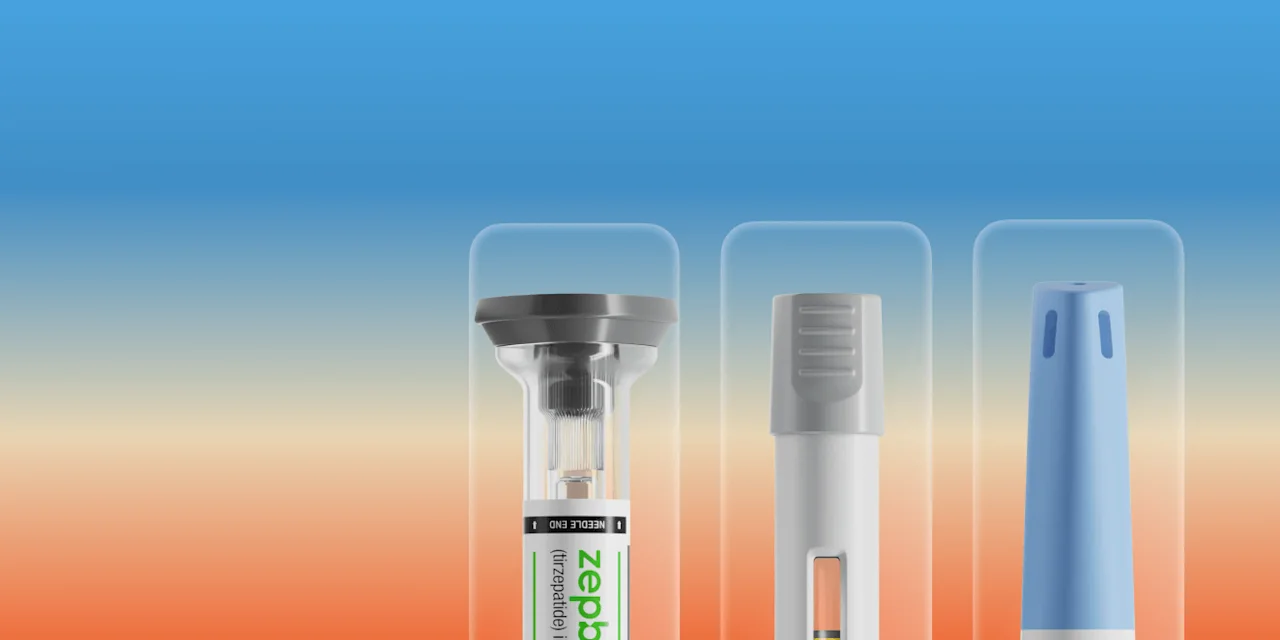Key takeaways
Diarrhea is considered a common side effect of tirzepatide, likely due to the drug’s effects on the digestive system.
While this side effect usually improves with time, there are several ways you can manage tirzepatide diarrhea. These include staying hydrated, avoiding trigger foods, limiting caffeine and alcohol, eating a bland diet, and considering OTC medications.
If you’re experiencing tirzepatide diarrhea, it’s a good idea to speak to your healthcare provider. They can recommend strategies to manage your symptoms. They may also adjust your medication dosage or switch you to an alternative treatment.
Here's what we'll cover
Here's what we'll cover
Here's what we'll cover
Key takeaways
Diarrhea is considered a common side effect of tirzepatide, likely due to the drug’s effects on the digestive system.
While this side effect usually improves with time, there are several ways you can manage tirzepatide diarrhea. These include staying hydrated, avoiding trigger foods, limiting caffeine and alcohol, eating a bland diet, and considering OTC medications.
If you’re experiencing tirzepatide diarrhea, it’s a good idea to speak to your healthcare provider. They can recommend strategies to manage your symptoms. They may also adjust your medication dosage or switch you to an alternative treatment.
GLP-1 medications, such as semaglutide (Wegovy, Rybelsus, and Ozempic), are notorious for causing gastrointestinal (GI) side effects, including nausea, vomiting, abdominal pain, and diarrhea. Tirzepatide (Mounjaro and Zepbound) — dual GLP-1/GIP agonists — can come with these side effects, too. Whether it is used for diabetes or weight loss, tirzepatide commonly causes diarrhea. So, why does tirzepatide cause diarrhea, and how can you manage tirzepatide diarrhea?
Keep reading to understand the relationship between tirzepatide and diarrhea, and how to manage this unpleasant side effect.
Does tirzepatide cause diarrhea?
Yes, diarrhea is one of the most common side effects of Mounjaro and Zepbound, both of which are brand-name drugs that contain tirzepatide as their active ingredient. In clinical trials of Mounjaro, 12%--17% of adults who took the drug for type 2 diabetes experienced diarrhea, compared to only 9% of those who took a placebo.
Similarly, in studies of Zepbound, 19%--23% of adults who took tirzepatide for weight loss reported having diarrhea; this was the case for just 8% of those who took a placebo.
In studies of both Mounjaro and Zepbound, the majority of cases occurred when the medication dosage was increased, and GI side effects were usually mild to moderate and decreased over time.
Why does tirzepatide cause diarrhea?
Although diarrhea is common with tirzepatide, experts don’t fully understand why the drug can often cause you to feel glued to the toilet. Complicating things further, some people may even experience the opposite — constipation — on tirzepatide. The way the drug works on the digestive system is the most likely reason.
Here’s how it works. Tirzepatide exerts its effects on weight loss and blood sugar by mimicking two naturally occurring hormones: glucose-dependent insulinotropic polypeptide (GIP) and glucagon-like peptide-1 (GLP-1). Through this mechanism, tirzepatide helps regulate your blood sugar and lower your appetite by encouraging more insulin release, decreasing glucose production, and slowing gastric emptying (i.e., the movement of food through the digestive tract). Its mechanism of action can lead to diarrhea in several ways.
Delaying gastric emptying
GLP-1 medications, along with dual agonists like tirzepatide, affect gut motility (the movement of food through the digestive tract) and slow gastric emptying (keeping food in the stomach for longer). While these effects can help with appetite reduction and blood sugar regulation, they can also alter normal digestion patterns and bowel movements.
Changing the intestinal environment
Your gut is filled with trillions of microorganisms that comprise the gut microbiome. These organisms play an integral role in your health by supporting digestion, nutrition, immunity, and several other functions. Everyone’s gut microbiome is unique, and sometimes, dietary changes or medications can alter your intestinal environment.
GLP-1 and dual GLP-1/GIP therapies appear to change the gut microbiome. These changes may lead to GI side effects, such as nausea, abdominal distension, constipation, and diarrhea. However, the relationship seems to be complex, and researchers are still working to understand exactly how these medications and gut bacteria interact.
Increasing fluid secretion
Tirzepatide increases the levels of gut hormones, such as GIP. This can lead to increased intestinal fluid secretion, which can contribute to loose and watery stools.
How long does tirzepatide diarrhea last?
It varies from person to person. Tirzepatide has a similar side effect profile as GLP-1 medications, and research has shown that diarrhea typically lasts for about three days in people who take GLP-1s for obesity.
According to studies of Mounjaro and Zepbound, diarrhea is most likely to occur when first starting treatment or raising your dosage, especially during the first four weeks of treatment. It is also more likely if you’re taking a higher dose of tirzepatide. In most cases, diarrhea is temporary and will improve as you get used to the medication. Nevertheless, if your diarrhea is severe or isn’t improving, consult your healthcare provider.
How to stop tirzepatide diarrhea
While most reports of diarrhea are mild and temporary, it can still be an uncomfortable side effect that affects your daily life. Fortunately, there are several ways to manage tirzepatide diarrhea, such as staying hydrated and modifying your diet.
Stay hydrated
Diarrhea can increase your risk of dehydration, so it is important to stay hydrated. Drink clear liquids, such as water, diluted fruit juices, or sports drinks (just be careful about drinking high-sugar or high-calorie drinks, especially if you’re trying to manage your diabetes or weight).
Avoid trigger foods
Keeping track of what you eat and your bowel movements can help determine which foods are triggering diarrhea. Certain foods are known to soften the stool and should be limited or avoided if you’re having diarrhea. These include:
Limit caffeine and alcohol
Caffeine can increase the activity of the colon and worsen diarrhea. Similarly, binge drinking has been linked to diarrhea. Therefore, if you’re experiencing tirzepatide diarrhea, it’s a good idea to steer clear of caffeine and alcohol.
Adjust your diet
A bland diet, or BRAT diet, can make stools firmer by easing the workload of your digestive system. Examples of bland foods include bananas, toast, oatmeal, white rice, applesauce, and broth.
Consider over-the-counter (OTC) medications
OTC antidiarrheal medications, such as loperamide (Imodium) and bismuth subsalicylate (Pepto-Bismol), may provide short-term relief. Loperamide slows down the movement of food and waste in the digestive tract, which allows the body more time to absorb water from stools. This helps firm up stools. Bismuth subsalicylate produces its antidiarrheal effects by reducing inflammation, limiting intestinal secretions, and promoting fluid and electrolyte reabsorption. It also has some mild antimicrobial effects, but it does not significantly alter normal gut bacteria.
However, like all medications, these options come with risks and may not be safe for everyone. Be sure to review the product warnings and follow the directions on the label. Reach out to your healthcare provider for guidance if diarrhea lasts more than two days despite taking OTC antidiarrheal medications.
Bottom line
If you’re taking Mounjaro or Zepbound and find yourself having diarrhea, your medication may be the culprit. Here are some key points to keep in mind if you’re having tirzepatide diarrhea:
Mounjaro and Zepbound commonly cause diarrhea. In studies, up to 17% of people taking Mounjaro reported diarrhea, while up to 23% of people taking Zepbound reported this side effect. In most cases, this effect is temporary, and improves as your body adjusts to the medication.
Diarrhea occurs due to tirzepatide’s effects on the digestive system. The medication can delay gastric emptying, alter the gut microbiome, and increase intestinal fluid secretion, all of which can lead to diarrhea.
Luckily, there are several ways to manage tirzepatide diarrhea, including staying hydrated, avoiding trigger foods, limiting caffeine and alcohol, eating a bland diet, and taking OTC medications if appropriate.
If you’re having tirzepatide diarrhea, it may be a good idea to speak to your healthcare provider. They can help determine if tirzepatide is the cause, and if so, they can recommend the best strategies to manage your symptoms. Aside from the strategies mentioned above, they may also adjust your medication dosage or switch you to an alternative treatment.
Frequently asked questions (FAQs)
Why am I having diarrhea on Mounjaro?
Diarrhea is considered one of the most common side effects of Mounjaro, likely due to its effects on the digestive system. Tirzepatide may cause diarrhea by altering the gut microbiome, though this relationship is complex and not fully understood. It can also raise levels of certain gut hormones, which increase intestinal fluid secretion and may lead to loose stools.
How long does Mounjaro diarrhea last?
Research has shown that diarrhea can last about three days in people who take medications like Mounjaro; however, side effects can vary from person to person. In most cases, this side effect is temporary and will go away as your body gets used to the medication. If your symptoms are severe or don’t improve with time, speak to your healthcare provider.
Can tirzepatide cause dumping syndrome?
It’s not likely. Dumping syndrome is a condition that occurs when food moves too quickly from the stomach to the small intestine. While tirzepatide can cause similar side effects as dumping syndrome, such as nausea, diarrhea, and abdominal pain, it isn’t known to cause dumping syndrome. In fact, there is evidence that tirzepatide may improve early dumping syndrome.
What are the most common side effects of tirzepatide?
The most common side effects of tirzepatide include nausea, diarrhea, vomiting, constipation, indigestion, abdominal pain, and injection site pain or irritation.
DISCLAIMER
If you have any medical questions or concerns, please talk to your healthcare provider. The articles on Health Guide are underpinned by peer-reviewed research and information drawn from medical societies and governmental agencies. However, they are not a substitute for professional medical advice, diagnosis, or treatment.
Wegovy Important Safety Information: Read more about serious warnings and safety info.
Ozempic Important Safety Information: Read more about serious warnings and safety info.
Zepbound Important Safety Information: Read more about serious warnings and safety info.
Mounjaro Important Safety Information: Read more about serious warnings and safety info.
GLP-1 Important Safety Information: Read more about serious warnings and safety info.
References
Budisak, P., Patel, P., & Abbas, M. (2024). Bismuth subsalicylate. StatPearls. Retrieved from https://www.ncbi.nlm.nih.gov/books/NBK560697/
DailyMed. (2024). Imodium A-D Drug Facts. Retrieved from https://dailymed.nlm.nih.gov/dailymed/fda/fdaDrugXsl.cfm?setid=01da76d0-1979-4c45-9d39-c72ae4e4ffe2&type=display
DailyMed. (2025). Pepto Bismol Drug Facts. Retrieved from https://dailymed.nlm.nih.gov/dailymed/fda/fdaDrugXsl.cfm?setid=67006e82-870d-8d63-e053-2991aa0a02d1&type=display
Gorgojo-Martínez, J. J., Mezquita-Raya, P., Carretero-Gómez, J., et al. (2022). Clinical recommendations to manage gastrointestinal adverse events in patients treated with GLP-1 receptor agonists: a multidisciplinary expert consensus. Journal of Clinical Medicine, 12(1), 145. doi:10.3390/jcm12010145. Retrieved from https://pubmed.ncbi.nlm.nih.gov/36614945/
Karrar, H. R., Nouh, M. I., Nouh, Y. I., et al. (2023). Tirzepatide-induced gastrointestinal manifestations: a systematic review and meta-analysis. Cureus, 15(9), e46091. Retrieved from https://pmc.ncbi.nlm.nih.gov/articles/PMC10614464/
Kato, S., Sato, T., Fujita, H., et al. (2021). Effects of GLP-1 receptor agonist on changes in the gut bacterium and the underlying mechanisms. Scientific Reports, 11(1), 9167. Retrieved from https://www.nature.com/articles/s41598-021-88612-x
Ludvik, B., Giorgino, F., Jódar, E., et al. (2021). Once-weekly tirzepatide versus once-daily insulin degludec as add-on to metformin with or without SGLT2 inhibitors in patients with type 2 diabetes (SURPASS-3): a randomised, open-label, parallel-group, phase 3 trial. Lancet (London, England), 398(10300), 583–598. Retrieved from https://pubmed.ncbi.nlm.nih.gov/34370970/
McKenzie, Y. A., French, C., Todd, C., et al. (2024). Food intolerance related to gastrointestinal symptoms amongst adults living with bile acid diarrhoea: A cross-sectional study. Journal of Human Nutrition and Dietetics : The Official Journal of the British Dietetic Association, 37(1), 79–93. doi:10.1111/jhn.13232. Retrieved from https://pubmed.ncbi.nlm.nih.gov/37735850/
Mishra, R., Raj, R., Elshimy, G., et al. (2023). Adverse events related to tirzepatide. Journal of the Endocrine Society, 7(4), bvad016. Retrieved from https://pmc.ncbi.nlm.nih.gov/articles/PMC9915969/
Nakamori, H., Iida, K., & Hashitani, H. (2021). Mechanisms underlying the prokinetic effects of endogenous glucagon-like peptide-1 in the rat proximal colon. American Journal of Physiology. Gastrointestinal and Liver Physiology, 321(6), G617–G627. Retrieved from https://pubmed.ncbi.nlm.nih.gov/34643099/
National Institute of Diabetes and Digestive and Kidney Diseases. (n.d.). Dumping Syndrome. Retrieved from https://www.niddk.nih.gov/health-information/digestive-diseases/dumping-syndrome
Nehlig A. (2022). Effects of coffee on the gastro-intestinal tract: a narrative review and literature update. Nutrients, 14(2), 399. Retrieved from https://pmc.ncbi.nlm.nih.gov/articles/PMC8778943/
Nemeth, V. & Pfleghaar, N. (2022). Diarrhea. StatPearls. Retrieved from https://www.ncbi.nlm.nih.gov/books/NBK448082/
Reding, K. W., Cain, K. C., Jarrett, M. E., et al. (2013). Relationship between patterns of alcohol consumption and gastrointestinal symptoms among patients with irritable bowel syndrome. The American Journal of Gastroenterology, 108(2), 270–276. Retrieved from https://pubmed.ncbi.nlm.nih.gov/23295280/
Sahi, N., Nguyen, R., Patel, P., et al. (2024). Loperamide. StatPearls. Retrieved from https://www.ncbi.nlm.nih.gov/books/NBK557885/
Shreiner, A. B., Kao, J. Y., et al. (2015). The gut microbiome in health and in disease. Current Opinion in Gastroenterology, 31(1), 69–75. Retrieved from https://doi.org/10.1097/MOG.0000000000000139
Singh, K., Aulakh, S. K., Nijjar, G. S., et al. (2024). Rebalancing the gut: glucagon-like peptide-1 agonists as a strategy for obesity and metabolic health. Cureus, 16(7), e64738. Retrieved from https://pmc.ncbi.nlm.nih.gov/articles/PMC11329331/
Stortz, E., & Lawler, H. (2024). Tirzepatide improves early dumping syndrome and glucose nadir in postbariatric hypoglycemia after sleeve gastrectomy. JCEM Case Reports, 2(11), luae194. Retrieved from https://pubmed.ncbi.nlm.nih.gov/39444516/
Taylor, K. & Tripathi, A. K. (2025). Adult dehydration. StatPearls. Retrieved from https://www.ncbi.nlm.nih.gov/books/NBK555956/
Trapanese, V., Dagostino, A., Natale, M. R., et al. (2025). Bidirectional interactions between the gut microbiota and incretin-based therapies. Life (Basel, Switzerland), 15(6), 843. doi:10.3390/life15060843. Retrieved from https://pmc.ncbi.nlm.nih.gov/articles/PMC12193786/
U.S. Food and Drug Administration (FDA). (2025). Mounjaro (tirzepatide) injection, for subcutaneous use: Full prescribing information. Retrieved from https://nctr-crs.fda.gov/fdalabel/services/spl/set-ids/d2d7da5d-ad07-4228-955f-cf7e355c8cc0/spl-doc
U.S. Food and Drug Administration (FDA). (2025). Zepbound (tirzepatide) injection, for subcutaneous use: Full prescribing information. Retrieved from https://nctr-crs.fda.gov/fdalabel/services/spl/set-ids/487cd7e7-434c-4925-99fa-aa80b1cc776b/spl-doc













